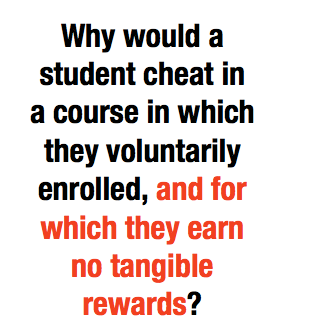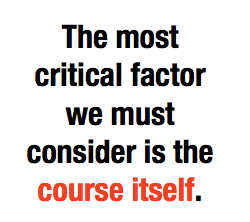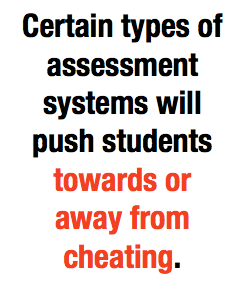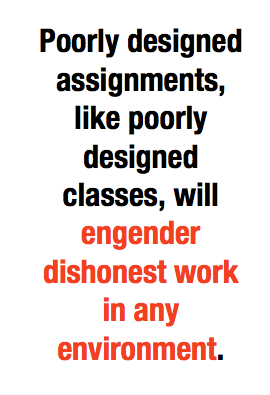By JAMES LANG
In August of 2012, the Chronicle of Higher Education published a story about a baffling phenomenon in the world of online higher education: students in a non-credit bearing MOOC (massive open online course) were cheating on the written assignments. The honest students complained about the plagiarized work they were seeing from their peers; in response the professor teaching the course gave a stern written lecture on academic dishonesty.
But the incident raised a question that educational theorists and cheating scholars have been puzzling over since: Why would a student cheat in a course in which they voluntarily enrolled, and for which they earn no tangible rewards? Jonathan Haber, a blogger documenting his efforts to earn the equivalent of a four-year college degree with a year’s worth of MOOCs, wrote that “during a period when MOOCs still carry uncertain external value, behaving dishonestly makes no practical sense (especially since students who can’t keep up with the work have other alternatives—such as simply dropping the course—an option that carries little to no social stigma).”
We should not jump too hastily to the conclusion that MOOCs carry no real stakes.
 Composition theorist and plagiarism researcher Rebecca Moore Howard points out that stakes do in fact exist for some MOOCs, even if they do not come in the form of college credit: “There actually are stakes for students in non-credit-bearing MOOCs, in that Coursera and other proprietors actually connect successful students with prospective employers.”
Composition theorist and plagiarism researcher Rebecca Moore Howard points out that stakes do in fact exist for some MOOCs, even if they do not come in the form of college credit: “There actually are stakes for students in non-credit-bearing MOOCs, in that Coursera and other proprietors actually connect successful students with prospective employers.”
But for the most part, and right now at least, Haber is right that the reward of succeeding in a MOOC has an “uncertain external value.” A student who cheats his way to a Harvard degree has earned a Harvard degree, one which will improve his career prospects immensely. A student who cheats his way to a MOOC certificate earns nothing of the sort (for the time being). So why are they doing it?
Existing research on cheating in higher education doesn’t take us very far in this regard. Analyzing the demographics of the cheating students and seeking to understand whether certain types of students are more likely to cheat than others (like in the work of Donald L. McCabe) doesn’t help in understanding cheating in MOOCs, since both the “massive” and “open” nature of the courses makes it difficult, if not impossible, to gain a clear picture of a typical MOOC student.
Other plagiarism theorists, such as Susan Blum, consider how contemporary cultural practices of sampling and borrowing are challenging our traditional definitions of plagiarism—and how they are confusing to students who must abandon their normal habits of Facebook sharing or re-Tweeting in order to conform to the complex rules of scholarly citation. This may have some bearing on the case of cheating in MOOCs, especially when the students hail from different countries, where the rules of academic citation might differ from those in the home country of the faculty member.
 But my own research on cheating in higher education suggests that the most critical factor we must consider in our understanding of the problem is the course itself. In other words, are there features of the learning environment—such as the design of the course or the nature of the assignments or the communications from the teacher—that induce or reduce the incentives and opportunities for students to cheat?
But my own research on cheating in higher education suggests that the most critical factor we must consider in our understanding of the problem is the course itself. In other words, are there features of the learning environment—such as the design of the course or the nature of the assignments or the communications from the teacher—that induce or reduce the incentives and opportunities for students to cheat?
Examined through this lens, cheating in MOOCs becomes more understandable. The same course design principles that induce cheating in a traditional college course may well induce cheating in a MOOC, even when the reward for success is uncertain.
Consider, for example, the question of learning orientation. Educational theorists like to distinguish between two orientations that students have towards learning: mastery or performance. Mastery-oriented students, driven by their own curiosity and desire for knowledge, seek to master a body of material; performance-oriented students want to perform well on the assignments and exams.
 Cheating researchers have argued that performance-oriented students are more likely to cheat than mastery-oriented ones. This makes a kind of intuitive sense. If the student cares about learning the material for its own sake, cheating does not serve this ambition well; if the student cares primarily about their performance on the assignments and exams, cheating becomes a much more attractive option.
Cheating researchers have argued that performance-oriented students are more likely to cheat than mastery-oriented ones. This makes a kind of intuitive sense. If the student cares about learning the material for its own sake, cheating does not serve this ambition well; if the student cares primarily about their performance on the assignments and exams, cheating becomes a much more attractive option.
But students do not carry around with them a simple, clear-cut learning orientation from one course to the next. In fact, the very design of a course’s assessment system (i.e., its specific package of assignments and exams) can nudge students towards mastery or performance orientations. This means that certain types of assessment systems will also push students towards or away from cheating.
The key way in which a course’s assessment system helps establish a mastery or performance-oriented classroom environment is through its use of—or lack of—choice and control. If a course’s assessment system requires all students to complete the same rote set of instructor-designed exams and assignments, that course implicitly focuses on performance. If you want to do well in such a course, you must succeed on these specific, pre-determined performances. Such a course offers no choice or control in terms of how students can demonstrate their learning to the instructor.
 A mastery-oriented course, by contrast, offers students a variety of ways to demonstrate their learning. Each student might, for example, be able to choose their own unique package of assignments from a menu of options offered by the instructor. Options like this will empower students to select those assessments that pique their interests and play to their strengths. These students are given choices and offered control over their path through the course material. Such individualized assessment systems also reduce the opportunity for students to cheat since the number of students completing any given assignment will be much smaller.
A mastery-oriented course, by contrast, offers students a variety of ways to demonstrate their learning. Each student might, for example, be able to choose their own unique package of assignments from a menu of options offered by the instructor. Options like this will empower students to select those assessments that pique their interests and play to their strengths. These students are given choices and offered control over their path through the course material. Such individualized assessment systems also reduce the opportunity for students to cheat since the number of students completing any given assignment will be much smaller.
My guess is that that course design principles like this play a major role in the amount of cheating that takes place in a MOOC—just as they do in a traditional course. As Jonathan Haber points out, in describing the assignments he has completed in his year of MOOCing, “With a few exceptions, the assessments I’ve been asked to take within my many MOOCs have felt like afterthoughts, which made them easier to not take seriously.” Poorly designed assignments, like poorly designed classes, will engender dishonest work in any environment, from traditional to online.
We’ll always have some small degree of cheating; that’s just human. But the best defense we have against cheating is excellence in course design and teaching. If a MOOC simply puts online a traditional teaching format—a teacher standing in front of a video camera and lecturing for forty-five minutes three times a week, and then demanding standard essays on well-worn topics—we should not be surprised to find students cheating, just as we would not be surprised to find them cheating in a face-to-face course of the same nature.
If we want to build MOOCs that foster honest work, we want to inspire students to learn for mastery, rather than focusing on the performance. We have to ensure that we are designing courses that offer students the opportunity to demonstrate their learning to us in creative and individualized ways.
James M. Lang is an Associate Professor of English and Director of the Center for Teaching Excellence at Assumption College. His new book, Cheating Lessons: Learning from Academic Dishonesty, was published this month by Harvard University Press. You can follow him on Twitter at @LangOnCourse or visit his website at http://www.jamesmlang.com.
This column is part of The Way We Think series. What happens when you get past the buzzwords and take a broader look at what the Internet is actually doing to transform our culture, our research, our tastes, and our ideas? In this series, the Daily Dot will publish major thinkers and fresh voices from diverse areas of our intellectual and cultural lives—science, literary criticism, photography, food blogging, biology, art history, wine, travel—on how our world is changing in concrete terms because of the Web.
Photo by e-basak/Flickr


